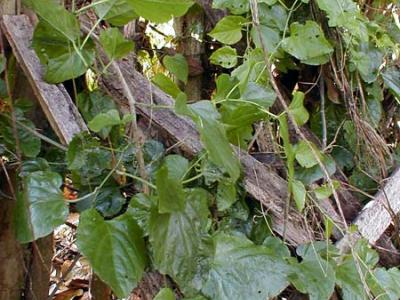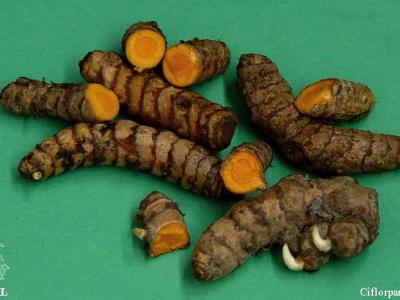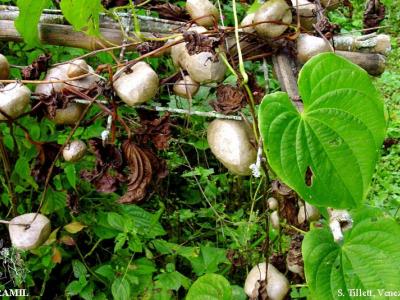(In territories with significant traditional TRAMIL use)
Dominican Republic:
- bejuco caro
Haiti:
- lyann mòl
leaf, lightly toasted, local application1-2
According to the information available:
Topical use for abscesses, lymph node disease and boils is classified as REC based on the significant traditional use documented in the TRAMIL surveys, the validation, toxicity and dermal irritability studies and the scientific information published.
All topical application must follow strict hygiene measures that prevent contamination or additional infection.
If deterioration is observed in the patient, if the abscess, lymph node disease and boils persist for more than 5 days, seek medical attention.
Oral use for colds, coughs and flu is classified as REC based on the significant traditional use documented in the TRAMIL surveys and the toxicity studies.
If deterioration is observed in the patient, and the cold, cough or flu persists for more than 5 days, seek medical attention.
Contraindicated in people susceptible to nervous depression or with antidepressant treatments.
Not for use during pregnancy because it can cause miscarriage, nor while breastfeeding or in children under 5 years of age.
The use for abscesses or lymph node disease:
wash the wound with boiled water and soap. Wash the leaves adequately, heat them slightly over a fire, take 5–10 grams of the plant material and apply directly to the injury. Cover with a dressing or a clean cloth and change twice a day.
For boils:
wash the injury with boiled water and soap, apply on the affected area in sufficient quantities. Cover with a dressing or clean cloth and change twice a day.
For use in colds, coughs or flu:
prepare a decoction with 30 grams of leaves in 4 cups (1 litre) of water, boil for 10 minutes in a covered vessel. Leave to cool, strain (filter) and drink 3 cups a day.
Preparations must never be stored for more than 24 hours, even if refrigerated.
1 WENIGER B, ROUZIER M, 1986
Enquête TRAMIL. Service Oecuménique d'Entraide SOE, Port au Prince, Haïti.
2 GERMOSEN-ROBINEAU L, GERONIMO M, AMPARO C, 1984
Encuesta TRAMIL. enda-caribe, Santo Domingo, Rep. Dominicana.
3 WENIGER B, SAVARY H, DAGUIHL R, 1984
Tri phytochimique de plantes de la liste TRAMIL. Laboratoire de chimie des substances naturelles, Faculté de Médecine et de Pharmacie, Université d'Etat d'Haïti, Port au Prince, Haïti.
4 PINEDA M, 1990
Fitoquímica de algunas plantas TRAMIL. Laboratorio enda-caribe, Santo Domingo, Rep. Dominicana.
5 GARCIA MD, QUILEZ AM, SAENZ MT, MARTINEZ-DOMINGUEZ ME, DE LA PUERTA R, 2000
Anti-inflammatory activity of Agave intermixta Trel. and Cissus sicyoides L., species used in the Caribbean traditional medicine. J Ethnopharmacol 71:395-400.
6 BELTRAME FL, SARTORETTO JL, BAZOTTE RB, CUMAN RN, CORTEZ DAG, 2001
Estudo fitoquímico e avaliação do efeito antidiabético do Cissus verticillata L (Vitaceae). Química Nova 24:783-785.
7 BARBOSA WLR, SANTOS WRAS, PINTO LN, TAVARES ICC, 2002
Flavonóides de Cissus verticillata e a atividade hipoglicemiante do chá de suas folhas. Rev Bras Farmacognosia 12:13-15.
8 DE SOUSA C, DE PAIVA T, BEZERRA P, FALCÃO J, OLIVEIRA F, SILVEIRA E, FERREIRA J, FREIRE D, RODRIGUES M, CLEA F, DE SOUSA F, DE CASTRO D, DA ROCHA S, DE BARROS G, 2007
Anti-diabetic activity of a fraction from Cissus verticillata and tyramine, its main bioactive constituent, in alloxan-induced diabetic rats. American J of Pharmacology and Toxicology 2(4):178-188.
9 STANDLEY PC, 1937
The flora of Costa Rica, Pt. I. Bot Serv Field Mus Nat Hist 18(391):398.
10 MARTINEZ MJ, LOPEZ M, BOUCOURT E, FUENTES V, MORON F, 2002
Evaluación de la actividad antiestafilocóccica de Cissus verticillata. Informe TRAMIL. Laboratorio Central de Farmacología, Facultad de Ciencias Médicas "Dr. Salvador Allende", La Habana, Cuba.
11 LE GRAND A, WONDERGEM PA, 1986
Activités antimicrobiennes et études bibliographiques de la toxicologie de dix plantes médicinales de la Caraïbe. Rapport TRAMIL. Dép. de Pharmacognosie, Universités de Groningen & Leyden, Hollande.
12 FENG PC, HAYNES LJ, MAGNUS KE, PLIMMER JR, 1964
Pharmacological screening of some West Indian medicinal plants. J Pharm Pharmacol 16:115-117.
13 JIU J, 1966
A survey of some medicinal plants of Mexico for selected biological activities. Lloydia 29:250-259.
14 GARCIA MD, QUILEZ AM, SAENZ MT, MARTINEZ DOMINGUEZ ME, DE LA PUERTA R, 2000.
Anti-inflammatory activity of Agave intermixta Trel. and Cissus sicyoides L., species used in South Caribbean traditional medicine.
J Ethnopharmacol 71(3):395-400.
15 MARTINEZ MJ, LOPEZ M, BOUCOURT E, BETANCOURT J, FUENTES V, MORON F, 2002.
Irritabilidad dérmica primaria de Cissus verticillata. Informe TRAMIL. Laboratorio Central de Farmacología, Facultad de Ciencias Médicas "Dr. Salvador Allende", La Habana, Cuba.
16 MARTINEZ MJ, LOPEZ M, BOUCOURT E, BETANCOURT J, FUENTES V, MORON F, 2002.
Toxicidad aguda tópica de Cissus verticillata. Informe TRAMIL. Laboratorio Central de Farmacología, Facultad de Ciencias Médicas "Dr. Salvador Allende", La Habana, Cuba.
17 CAMBAR P, 1992
Efecto de los extractos acuosos de Cissus verticillata L. Informe TRAMIL. Unidad de Farmacología, Facultad de Ciencias Médicas, Universidad Nacional de Honduras UNAH, Tegucigalpa, Honduras.




